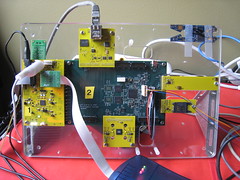A slightly baffling but intriguing phrase caught my eye in an Exbiblio email recently: “Cruelty-free tantalum.” I wondered what this was about and had a look around the internet to find out more. I discovered that it is an evolving story, not unconnected with an event in the news.
 Last Sunday, the people of war-torn Congo queued up at the election booths in a remarkable exercise in democracy. Despite its official name, this was the first election in the Democratic Republic of Congo since 1960. Congo is one of those countries that is, in a way, cursed by wealth. The violence that has raged since 1994 through this central African country is largely a battle to control Congo’s mineral resources which include diamonds, copper, and ores such as tantalite which is known locally as coltan.
Last Sunday, the people of war-torn Congo queued up at the election booths in a remarkable exercise in democracy. Despite its official name, this was the first election in the Democratic Republic of Congo since 1960. Congo is one of those countries that is, in a way, cursed by wealth. The violence that has raged since 1994 through this central African country is largely a battle to control Congo’s mineral resources which include diamonds, copper, and ores such as tantalite which is known locally as coltan.
Tantalum has has a high melting point and is capable of storing and slowly releasing an electric charge. Understandably, it is used widely in electronics. The rising popularity of mobile phones and gadgetry caused the value of this mineral to climb steeply during the 1990s, and then slump in 2000 along with the tech crash. 80% of the world’s tantalum is in Congo.
Many of Congo’s poorest farmers, including children, were drawn to tantalite ore, either as independent prospectors, or seeking work in the mines. Tantalite became a focus for fighting and banditry. Some of the deposits fell into the hands of rebels who used forced labour.
A tantalum rush ensued, and a legion of small farmers took their picks and shovels into Congo’s Kahuzi-Biega National Park in search of the mineral. The park is one of the last habitats of the extremely shy and retiring mountain gorilla. The incursion of miners has posed a threat to the existence of last 250 gorillas living in the park.
The unfortunate set of circumstances surrounding Congolese tantalum has given rise to campaigning against buying this mineral from Congo. But things aren’t always so simple on the ground. Many local people found tantalum to be an important source of income, and were dismayed when prices fell in 2000. I quote from a BBC report:
“It’s our only way of making a living,” said Blanchard, an intermediary who travels upcountry to buy coltan from the small-scale miners and brings it back to Goma to sell. “There’s nothing else to do here.”
These distant events have a direct bearing on Exbiblio’s policy of ethical sourcing, but I’m not sure that this is a straight-forward moral issue. Tantalum has been a motivation for banditry and the exploitation of miners, and some of it is tainted by “blood” just as much as conflict diamonds. In some cases, its extraction has disturbed families of gorillas, but refugees from the war have also been a big problem for the animal life of the National Park. On the other side of the argument, tantalum has also provided income to extremely poor Congolese. Congo is still a violent place, but its nascent democracy needs all the help it can get. It needs to move on from the civil war in which almost 4 million people have died (mostly through hunger and disease)– a staggering death toll that has gone largely unnoticed by the world. You can buy tantalum from Australia, and be sure that your hands are clean, but can you be certain that you aren’t turning your back on one of the most needy parts of the world? Bear in mind the verdict of The Economist newspaper on the Congolese election:
The best chance for a generation, unless the world walks away.



 Last Sunday, the people of war-torn Congo queued up at the
Last Sunday, the people of war-torn Congo queued up at the 